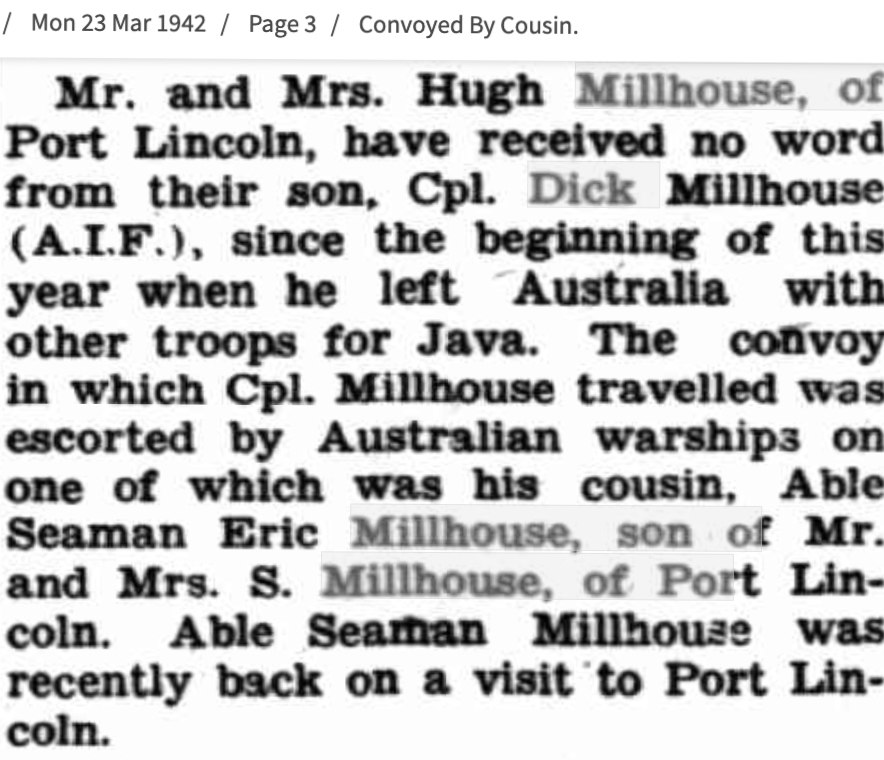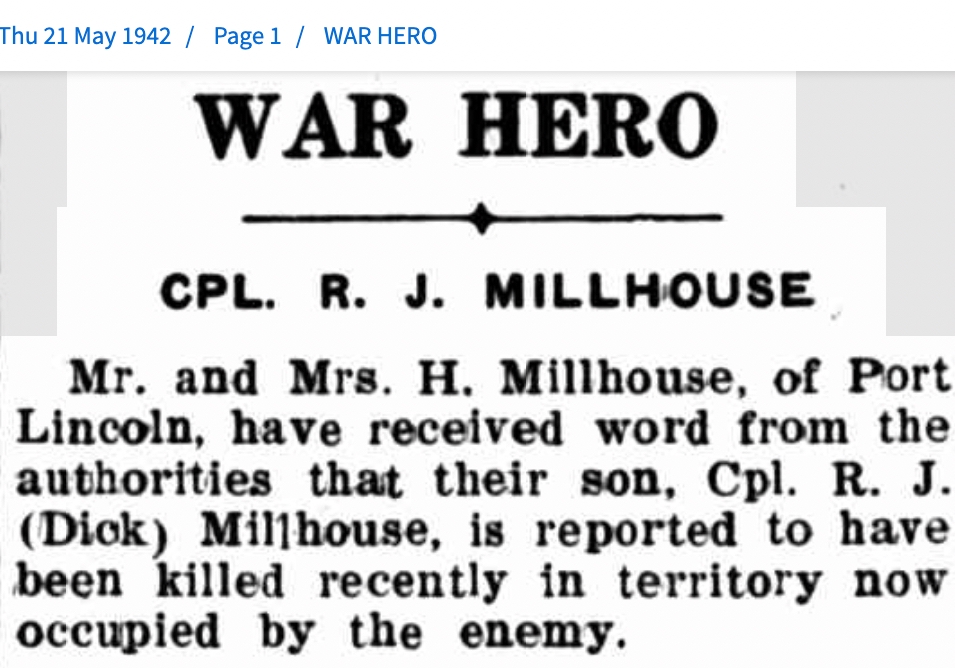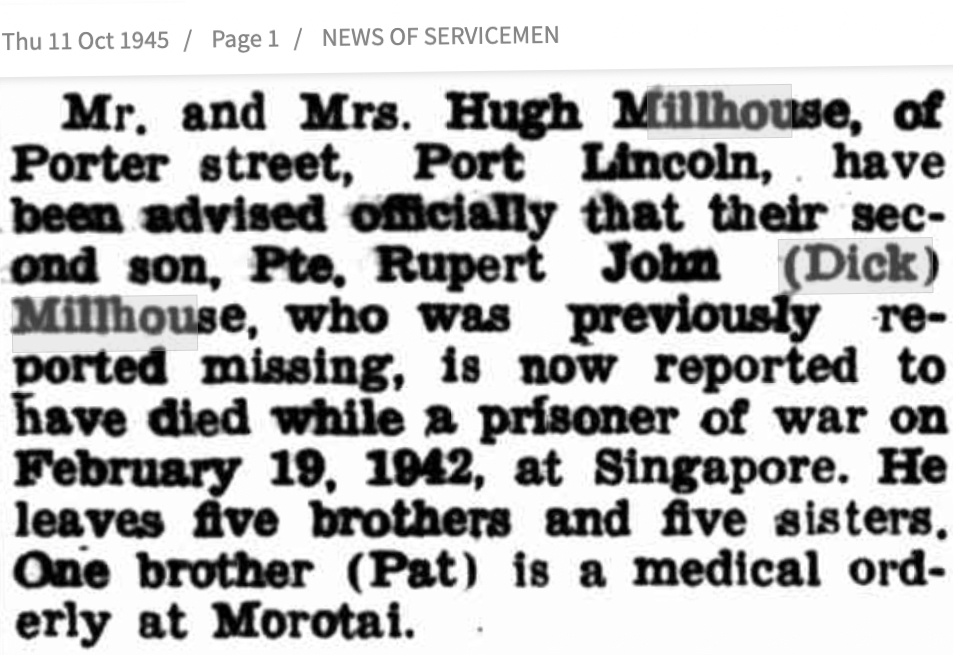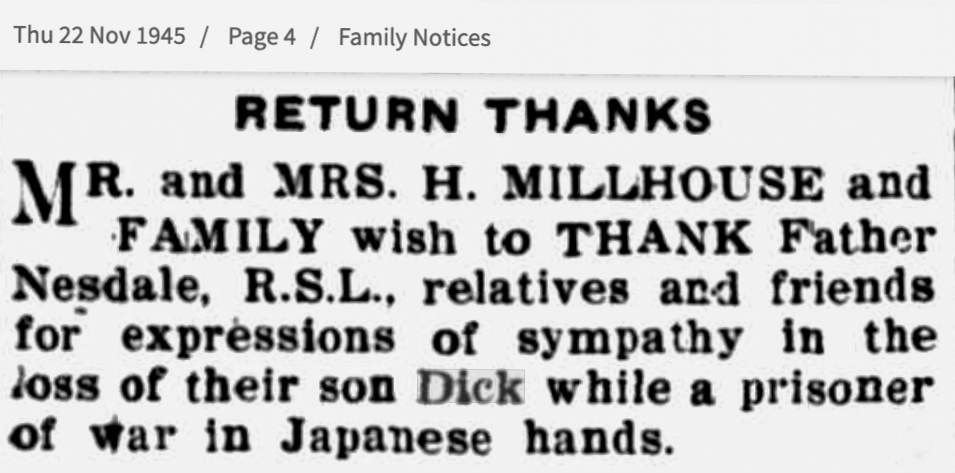The Soldier's Details

- Surname:
- Millhouse
- First Name:
- Rupert John
- Nick Name:
- Dick
- Rank:
- Private
- Regimental #:
- WX16675
- Company:
- ‘E’ Company, Special Reserve Battalion, No. 1 Platoon
- Enlisted:
- 22.09.1941
- DOB:
- 14.08.1919
- Place of Birth:
- Port Lincoln, South Australia
- Father's Name:
- Hugh (Hughie) Percy Gilbert Millhouse
- Mothers's Name:
- Joan Margaret Lucy Millhouse (nee Kennedy)
- Religion:
- Roman Catholic
- Pre-war Occupation:
- Farrier
- Memorial:
- Kranji War Cemetery, Plot 32, Row C, Grave 13, Age 23.
- Cause of Death:
- Executed by a Japanese firing squad
- Place of Death:
- Singapore
- Date of Death:
- 19.02.1942
General Description
Millhouse enlisted 23 September 1941 and joined 2/4th reinforcements ‘E’ Company. He recorded his father Hughie Millhouse, of Port Lincoln, South Australia as his NOK. He provided his address on two occasions – Federal Chambers, Kalgoorlie and 101 Brookman Street, Kalgoorlie. His occupation Farrier.
‘E’ Company ran into a Japanese ambush on 11th February 1942 at SW Bukit Timah. About 88 of 200 men survived. Dick Millhouse was one of the fortunate, although severely injured, he survived and took refuge behind the Japanese Lines as did many others and the enemy brigade headed south to Singapore.
Read further about ‘E’ Company
Wounded in action South-West Bukit Timah receiving four gunshot wounds to the right leg. Missing in action from 11.2.1942. He was taken prisoner with other soldiers and executed on 19 Feb 1942 by a Japanese firing squad for no apparent reason, at map reference 753097.
Privates Les McCann and Rupert Millhouse (Ockerby & Airey)
The ambush at South-West Bukit Timah on Wednesday 11th February, Les McCann was wounded in the right leg by mortar fire and took refuge with 3 or 4 other soldiers in one of the native huts at the opposite side of the clearing. On 13th February he was joined by Rupert Millhouse who had received 4 machine gun bullets to the right leg.
The next day the two men decided to move out towards the West Coast Road. That evening they received medical attention at the Mohammedan’s Institute where on 15th February they were informed that all British forces had surrendered to the Japanese. On the morning of 16th February McCann and Millhouse moved out again along West Coast Road where they met 3 other Australians near Pasir Panang Village. At the entrance of a house the 5 men were stopped by the Japanese sentries and ushered inside. They were then locked in a room fitted with barred windows. At about 1800 hours that evening they were taken outside and put on a truck. At the gate they met another Japanese who was escorting more Australians including R.S. Fred Airey and Private Harold Ockerby; the remainder were all members of 2/28th Battalion. R.S.M. Airey had been conscripted to drive trucks for the Japanese for the purpose of collecting Japanese bodies to be taken to the crematorium.
Airey and Magill both survived and escaped. Airey to Islands and Magill went to Changi. Millhouse and Ockerby died.
Please read Les McCann’s ‘Two came Home – The Firing Squads’
McCann wrote in detail about Rupe Millhouse – they were together several days during which time McCann cleansed and looked after Millhouse’s GSW’s.
R.S.M. Airey who also survived the firing squad wrote of Pte. Millhouse that he thought him gallant to the last as he let his executioners know exactly what he thought of them with his last breath of life.
Millhouse, brave to the end was too young at 23 years of age, especially to die by firing squad.
Below: The Millhouse family did not have Rupert’s death at Singapore officially confirmed until Oct 1945.
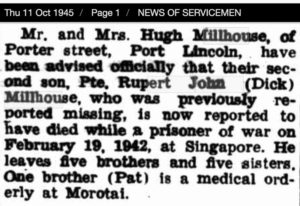



Hugh Percy Millhouse and his wife Joan Margaret Lucy Kennedy named their son after Hugh’s brother who died in WW1. Millhouse from Mt. Gambier, enlisted Adelaide 9 August 1915 aged 27 years, and joined 12th Reinforcements 10th Battalion.
Rupert Victor Mayfield Millhouse had not long returned to his Battalion in France from hospital in England where he was treated for GSW to his shoulder and arm when KIA 30 June 1918. He was later buried Borre British Cemetery, about 1.5 miles east of Hazelbrouck, France (56 km south east of Calais).
Service No. 3809 – Cpl Rupert Victor MILLHOUSE – The below information has been collated from 6 eye witness reports of the death of Cpl Rupert Millhouse in a Red Cross File
Rupert Millhouse, from Lucindale, Mt Gambier, SA. – had some connection with Mt Gambier State School.
10th Infantry Battalion,
5 Platoon, B Coy.
12th Reinforcements – Arrived 2 Dec 1915 per ‘Malawa’
Description: Millhouse was well built, tall (5’11”) with red hair, inclined to be fair skinned.
There were 23 men in a trench near Monte Merris on night of 29thth June 1918. At about 5 am the next morning, the Germans raided and Millhouse was killed instantly, shot in the head.
Only five men survived. One report said the Germans were attacking continuously, but only got through one post before retiring.
Millhouse’s body was removed to Borre Military Cemetery.
‘Merris May – July 1918
Merris is a small town in the far north of France adjacent to the Belgian border.
The 1st Division of the AIF had been rushed south in late March April to stem the advance on the Somme but was hastily returned and was deployed to stem another German offensive along the line of the Franco Belgian border. In this region Operation Georgette, the second largest of the Geman lines of attack had aimed to strike towards the Channel Ports at Calais via the important rail head of Hazebrouk.
Hazebrouk was held and the German offensive stalled as it had further south, short of their objectives.
During May and June of 1918, the Australians engaged in ‘Peaceful Penetration’ attempting to win back ground lost to the Germans via small stealthy ‘snatch and grab’ attacks that seized German outposts.’
Peaceful Penetration – April – August 1918 France
‘Peaceful Penetration’ was a term applied to Australian infantry tactics used in the period April to August 1918 (although it was also used by the New Zealanders). The term is attributed by Bean (1) to a term coined pre-war to German encroachment of the British Empire. The tactics were a cross between trench raiding and patrolling. The aim was similar to trench raiding (namely, to gather prisoners, conduct reconnaissance and gather intelligence), but increasingly the aim was to dominate no man’s land and where the situation presented itself, the additional purpose of capturing and occupying the enemy’s outpost line (and so gain ground).
We acknowledge and thank Virtual War Memorial for the above information. If you wish to read further please go to https://vwma.org.au/explore/campaigns/31
We wish to acknowledge and thank Mr. Tom Bakewell, great nephew to ‘WX 16675 Dick’ Millhouse who provided family information. Tom had only recently discovered the existence of ‘Dick’ Millhouse when researching his great uncle Rupert Victor. May 2019.

In his Red Cross file, there were six eye witness reports of Rupert Millhouse’s death – all varied to a small degree, however this is our interpretation of those combined reports:
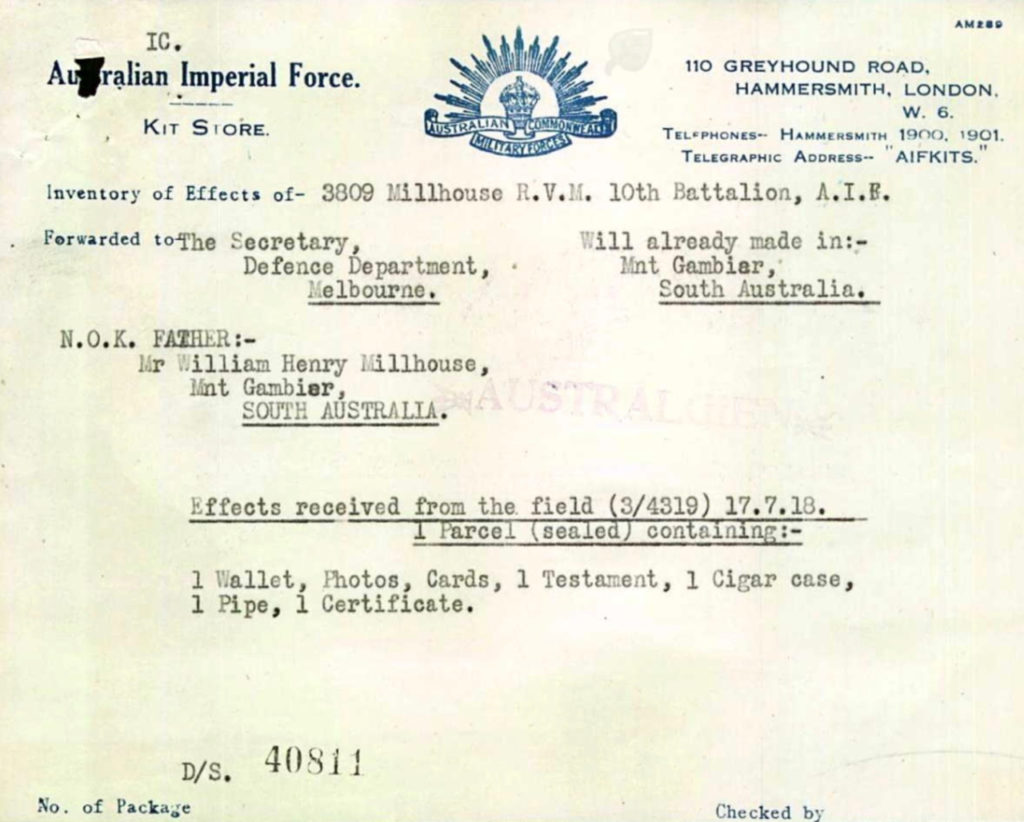
Above: although not the most relevant information contained in Rupert Millhouse (Snr’s) file, this tells the story of the end of a young man’s life.
Rupert John was known as Dick to his family and Rupe to his army mates. He was born Port Lincoln 1919 and was one of 6 sons and five daughters and the fifth born.
It is not known when Rupert John Millhouse came to WA, however he was recorded living Westonia, in the Murchison and working as a miner prior to enlistment. Westonia, a goldmining town, about 300 km east of Perth and a little more than half way between Northam and Kalgoorlie on the Great Eastern Highway.
He was residing at Kalgoorlie when he enlisted on 4 July 1941
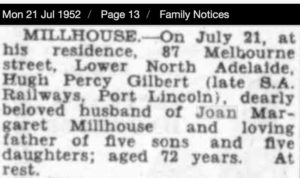
Hugh Millhouse died in 1952.
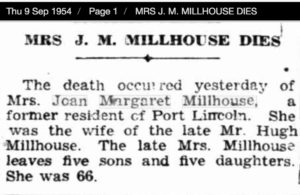
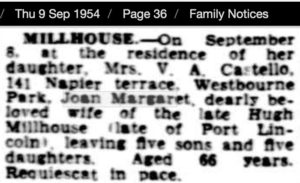
Below: death of Dick Millhouse’s grandfather in 1932.
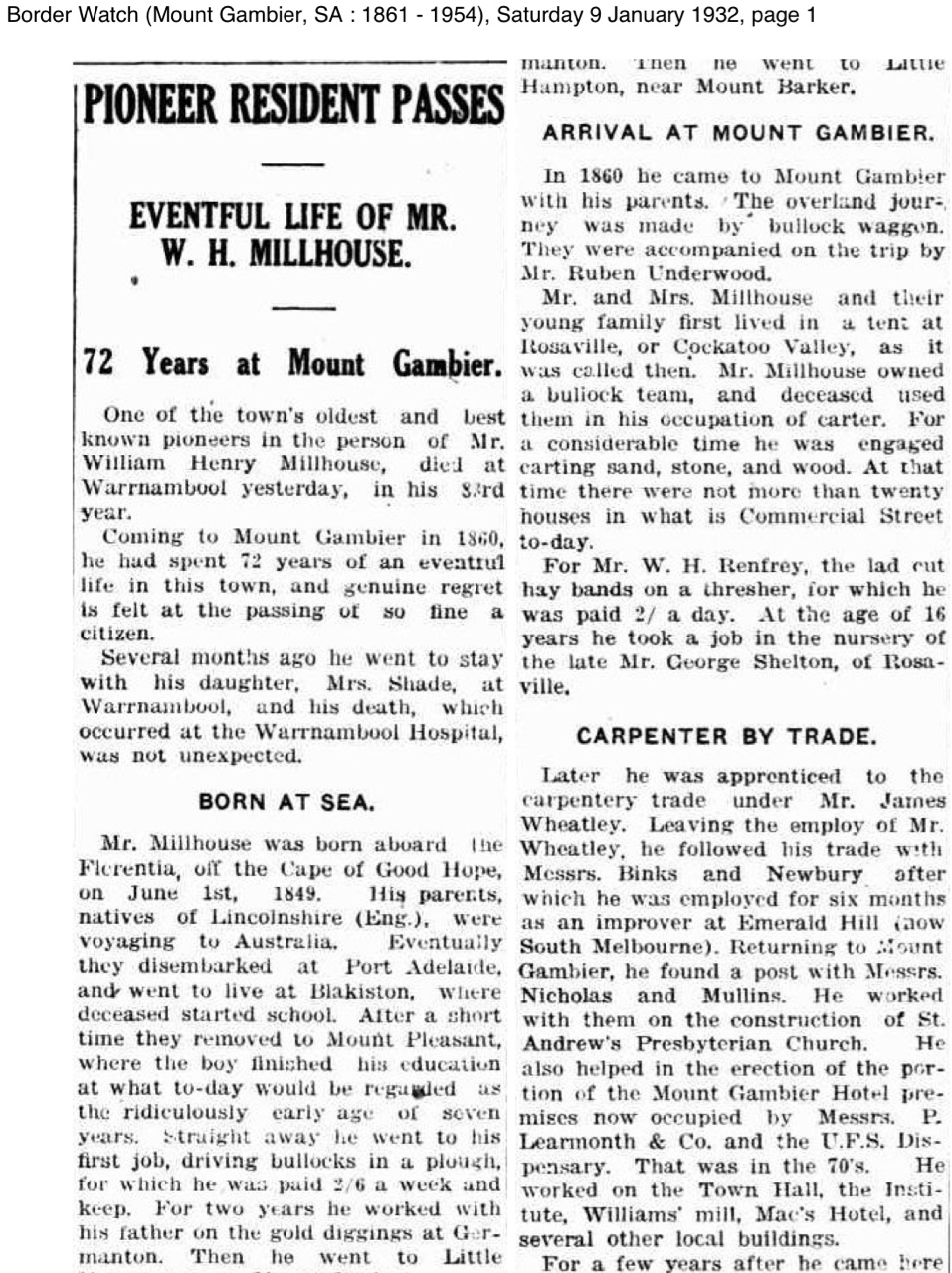
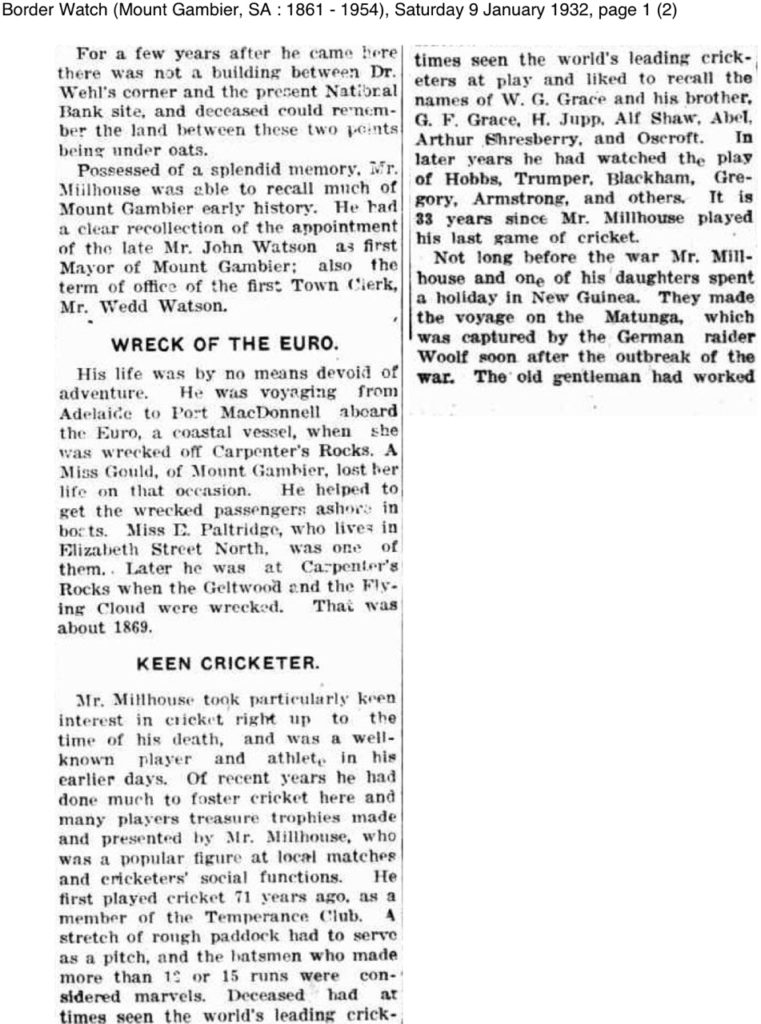
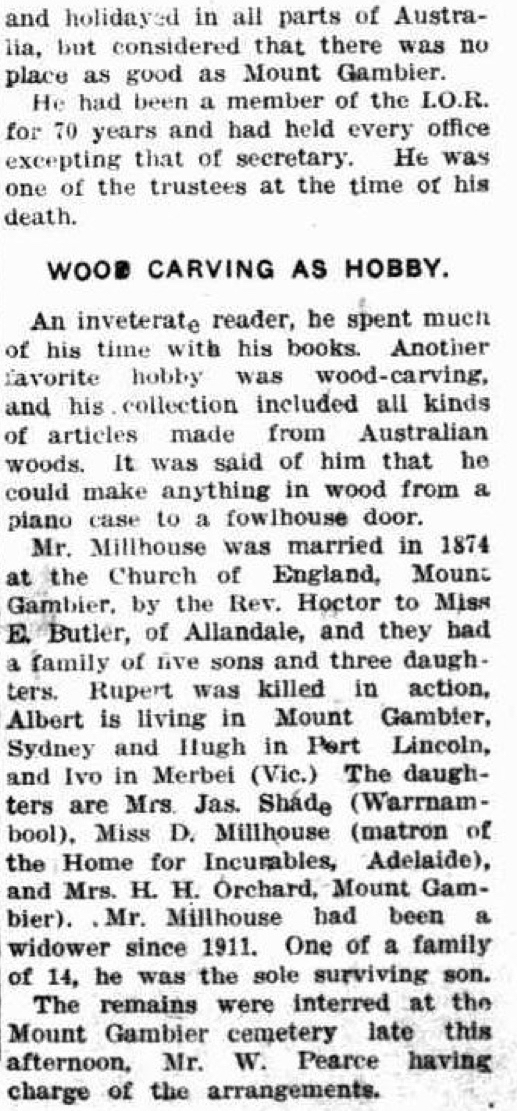
Above: history of the Millhouse family.
Joan Millhouse died 8 Sep 1954 aged 66 years and Hughie died 21 July 1952 aged 72 years.
